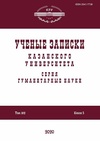Аравия (Арабия) по данным древнеармянского памятника V – VII веков «Ашхарацуйц»
Arabia according to the ancient Armenian monument “Ashkharatsuyts” dated the 5th–7th centuries
Author(s): Akop Zhoraevich HarutyunyanSubject(s): Archaeology, Cultural history, Physical Geopgraphy, Maps / Cartography, Ethnohistory, Local History / Microhistory, Ancient World
Published by: Казанский (Приволжский) федеральный университет
Keywords: “Ancient Armenian Geography”; “Ashkharatsuyts”; Arabia (Petraea; Felix; Deserta); Arabian Peninsula;
Summary/Abstract: The “Ancient Armenian Geography” (“Ashkharatsuyts”) places a special emphasis on the historical and geographical description of the Arabian Peninsula as a whole. Here, Arabia is considered as two countries of Universal Asia: the 25th and 28th countries are referred to as Arabia Petraea and Felix, respectively. The desert part of Arabia (Arabia Deserta) is also mentioned, but the authors (Movses Khorenatsi, Ananias of Shirak) only outline the boundaries of the peninsula. In addition to the geographical and historical information, the “Ashkharatsuyts” gives details on the socio-economic and cultural development of the population residing in the region. There is also a racial map, as well as the information about fossil resources, flora, fauna, etc. Similarly to the earlier works by other scholars (Strabo, Pliny the Elder, Pomponius Mela, Ptolemy, et al.), the “Ashkharatsuyts” is focused on all sections and subcategories of geography (from anthropogeography, cartography, local history, physico-economic geography to military geography, plant geography, physical geography (orography and hydrography), etc.). In this paper, each fragment of the text devoted to Arabia is explained on the basis of hermeneutic principles. Toponyms are interpreted using historical and linguistic analysis. Controversial issues are considered in the perspective of comparison with data from other sources. The results obtained contribute considerably to the study of the Arabian Peninsula by appealing to historical sources along with archaeological data.
Journal: Ученые записки Казанского университета. Серия Гуманитарные науки
- Issue Year: 163/2021
- Issue No: 3
- Page Range: 137-150
- Page Count: 14
- Language: Russian

